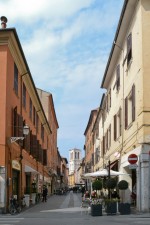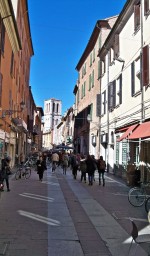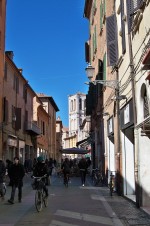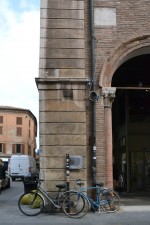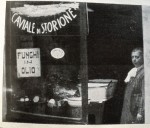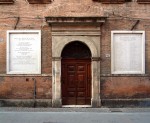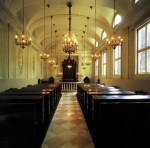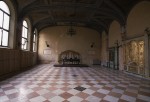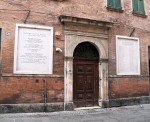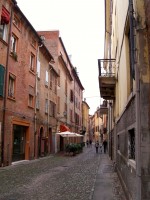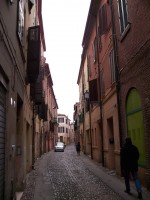Via Mazzini
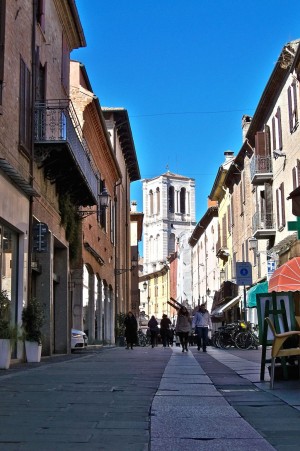
Via Mazzini (formerly known as Via dei Sabbioni). Photograph by Federica Pezzoli, 2015. © MuseoFerrara
Once known as Via dei Sabbioni, it is the main thoroughfare of the Jewish settlement. At civic number 95 are the complex of synagogues, which still serve as the headquarters of the Jewish community today.
1. History
On the left side of Piazza Trento e Trieste, Via Mazzini begins, originally called Via dei Sabbioni. It was named after the sand that was spread on it to make it more passable during rainy seasons, or more likely, it was named after the practice of sprinkling sand on it during public games.
From the beginning of the 15th century, it became the main street in the residential area of the Jewish community, concentrated within the quadrilateral formed by Via Mazzini, Via della Vittoria, and Via Vignatagliata. While the latter are primarily residential areas, on Via Mazzini you find the shops and activities of the Ferrarese Jews. Even today, the buildings are characterised by windows facing the street and being closely adjacent to one another, forming a long unified façade. Internally, they reveal courtyards that provide access to other buildings not facing the main street.
2. The ghetto
As a historic settlement for the Jewish community in Ferrara, the area was chosen by the Papal government for the establishment of the city's ghetto between 1624 and 1627. Due to its centrality, the ghetto's boundaries were defined by the installation of five gates, which were opened at dawn and closed at sunset: two at the ends of via Mazzini, two at the ends of via Vignatagliata, and one at the intersection of via della Vittoria and via Ragno.
Between the 18th and 19th centuries, the history of Ferrara's ghetto became eventful: the gates were torn down twice and then restored at the expense of the Jewish community. Only in 1848 were they definitively demolished, marking the beginning of the emancipation era in Ferrara.
3. In literature
The name of this important road in the old town and Jewish ghetto of Ferrara appears multiple times in the work of Giorgio Bassani. It is even part of the title of the third novella in Five Stories of Ferrara: ‘A Memoria Tablet in Via Mazzini’, whose pages contain a literary description that offers insight as to its appearance and atmosphere.
‘In writing an account of it, there’s the risk that the scene might look rather implausible, a piece of fiction. Even I have doubts about its veracity every time I consider it within the frame of what for us is that familiar, usual street: Via Mazzini, the street that is, which leaving the Piazza delle Erbe, and flanking the quarter of the erstwhile Ghetto—with the San Crispino Oratory at the foot, the narrow cracks of Via Vignatagliata and of Via Vittoria halfway down, the baked-red façade of the Jewish Temple a little farther on, as well as, along its entire length, the crowded rows of stores, shops and little outlets facing each other—still today serves as the main route between the historic centre and the Renaissance and modern parts of the city.
Immersed in the brilliance and silence of early afternoon, a silence which at wide intervals was interrupted by gunshots, Via Mazzini seemed empty, abandoned, preserved intact.’
(G. Bassani, ‘A Memorial Tablet in Via Mazzini’, in The Novel of Ferrara, translated by Jamie McKendrick, W. W. Norton & Company, 16 October 2018)
Bibliography
- G. Bassani, Jamie McKendrick, W. W. Norton & Company, ‘A Memorial Tablet in Via Mazzini’, in The Novel of Ferrara, translated by Jamie McKendrick, W. W. Norton & Company 16 October 2018
- Bassani, Giorgio, Una lapide in via Mazzini in Il romanzo di Ferrara, I, Arnoldo Mondadori, Milano 1998, pp. 87-127
- Luoghi ebraici in Emilia Romagna, Touring Club Italiano, Milano-Bologna 2006
- Melchiorri, Gerolamo, Bassi, Carlo, Nomenclatura ed etimologia delle piazze e strade di Ferrara. Ampliamenti all'opera di Gerolamo Melchiorri, 2G, Ferrara 2009
- Provasi, Matteo, Ferrara ebraica, 2G Editrice, Ferrara 2010
- Comune di Ferrara, Comunità Ebraica di Ferrara, Ferrara. Il ghetto Vai al testo digitalizzato
Fototeca
Related Subjects
Related places
Related Itineraries
Compiling entity
- Istituto di Storia Contemporanea di Ferrara
- Assessorato alla Cultura e al Turismo, Comune di Ferrara
Author
- Federica Pezzoli
- Sharon Reichel
- Barbara Pizzo

